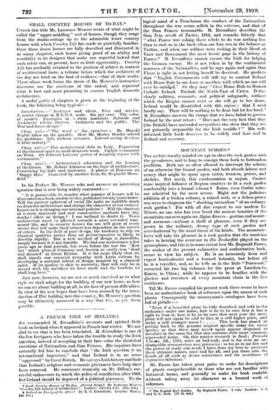SMALL COUNTRY HOUSES OF TO-DAY.*
UnDER this title Mr. Lawrence Weaver treats of what might be called the " upper-middling " sort of houses, though they range from the studio-cottage up to the admirable lesser country houses with -which Country Life has made us gratefully familiar. Over three dozen houses are fully described and illustrated in as many chapters, each house giving proof of an ability and sensibility in its designer that make one regretful indeed that such talent can, at present, have so little opportunity. Country Life has gradually attained to the position of arbiter in matters of architectural taste, a tribune before which the architects of the day are tried on the beat of evidence—that of their works. Those whose work forms the thesis of Mr. Weaver's instructive discourse are the survivors of this ordeal, and represent what is best and most promising in current English domestic architecture.
A useful précis of chapters is given at the beginning of the book, the following being typical :— Intreduction.—" Architect and client. Foes and service. A recent change in R.L.13.A. scale. Six per cent. The value of models. Examples in verious materials. Subsoils and Architects' advice thereon. Architects and the public. The War and house design."
Chap. xvii.—" The word o' the eyowitne s. Mr. Harold Begbie takes up the parable. How Mr. Morley Herder solved his problems. Life without servants. Labour-saving devices. A little oratory."
Chap. xxii.—" Our architectural debt to Italy. Expression of the classical spirit in small domestic work. Carlyle's comment on Wren. Sir Edward Lutyens' power of mingling repose with cariousness."
Chap. amyili.--" Architectural education and the housing of the future. Mr. Robert Atkinson on the logic of architecture. Concerning big halls and staircases. A phrase of Emerson on ' Happy Hits.' Corrected by another froin Sir Reginald Blom- field. '
In his Preface Mr. Weaver asks and answers an interesting question that is now being widely canvassed :- " It is permissible to wonder what manner of houses will be illustrated in a book similar to this, published twenty years hence. Will the present upheaval of social life make an indelible mark on domestic architecture and change the character of our country houses as it is changing our national policies ? Will the shortage of certain materials and new constructive methods have any marke I effect on design ? I am inclined to doubt it. Town architecture must Le affected towards a more extended com- munal life, and in country houses the use will grow of every device that will make their owners less dependent on the service of others. In the field of pure design, the tendency to rely on classical qualities rather than on picturesqueness is likely to develop rapidly. But a new method of design is incredible, simply because it is not feasible. We had our misfortunes a few years ago in that pursuit, but even before the war the ' New Art' which pleased Germany and Austria so vastly was dead and damned' in Great Britain. It is far more likely that we shall signify our essential sympathy with Latin culture by developing a national school of design inspired by a classical spirit. if its quality is akin to austerity, that will only be in accord with the sacrifices we have made and the burdens we shall long bear."
Just now, however, we are not so much exercised as to what style we shall adopt for the building of our new home, as how we can set about building at all, in the face of present difficulties. In view of the new hopes that have been aroused by the intro- duction of Pine building into this country, Mr. Weaver's question may be ultimately answered in a way that few, as vet, deem
possible.










































 Previous page
Previous page